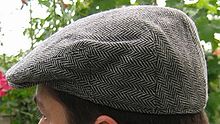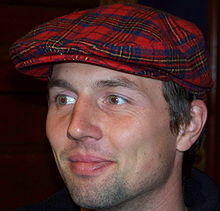- Flat cap
-
A flat cap is a rounded men or women's cap with a small stiff brim in front. Cloths used to make the cap include original wool, tweed (most common), and cotton. Less common materials may include leather. Cord flat caps are also worn in various colours. The inside of the cap is usually lined with silk for comfort and warmth. In recent years, it has received strong competion from the baseball cap.
Contents
History
The style can be traced back to the 14th century in Northern England namely Grimsby and parts of Southern Italy, when it was more likely to be called a "bonnet", which term was replaced, except in Scotland, by "cap" before about 1700.[1] When Irish and English immigrants came to the United States, they brought the flat cap with them. This style of cap is also referred to in some parts of the UK as a cheesecutter cap because of its wedge shape.
A 1571 Act of Parliament to stimulate domestic wool consumption and general trade decreed that on Sundays and holidays, all males over 6 years of age, except for the nobility and persons of degree, were to wear caps of wool manufacture on force of a fine (3/4d (pence) per day). The Bill was not repealed until 1597, though by this time, the flat cap had become firmly entrenched in English psyche as a recognized mark of a non-noble subject; be it a burgher, a tradesman, or apprentice. The style survives as the Tudor bonnet in some styles of academic dress.
Flat caps were almost universally worn in the 19th century by working class men throughout Britain and Ireland, and versions in finer cloth were also considered to be suitable casual countryside wear for upper-class English men (hence the contemporary alternative name golf cap). Flat caps were worn by fashionable young men in the 1920s.
The stereotype of the flat cap as purely "working class" was never correct. They were frequently worn in the country, but not in town, by middle and upper-class males for their practicality. Mather says: "A cloth cap is assumed in folk mythology to represent working class, but it also denotes upper class affecting casualness. So it is undoubtedly classless, and there lies its strength. A toff can be a bit of a chap as well without, as it were, losing face."[2] When worn by an upper-class gentleman, it is sometimes referred to as a slummers' cap. The British workman no longer commonly wears a flat cap, so in the twenty-first century, it has gained an increasingly upper class image. Though in Britain the flat cap is frequently worn as part of an "urban" or "street" look favoured by the working classes and thus, the balance is maintained.
Academic regalia
Main article: Academic regaliaOne of the flat hats worn in academia is known as a bonnet or Tudor bonnet and derives directly from medieval headgear of the period of the original 1571 Bill. It remains essential ceremonial wear by members of the academic community, in many countries around the world, usually as the headgear of doctoral graduates (PhD's). Commonly it has a soft round crown and a stiff flat brim. The bonnet is often made of black velvet and trimmed, between crown and brim with gold cord and tassels. Some universities opt to trim their bonnets with coloured cord and tassels.
Some stylistic varieties of this bonnet include:
- the Canterbury cap, a flat-topped soft cloth hat with a round headband deeper at the back than at the front;
- the Oxford bonnet, which has a black ribbon between crown and brim;
- the John Knox cap, a soft square cap made from black velvet and worn by the Doctors of certain Scottish Universities as well as Durham University in England, the University of Calgary and Queens' University in Canada;
The other main hat is the academic cap.
Youth culture
Boys in the United Kingdom and North America of all classes wore this cap in the late 19th and early 20th centuries. The hat is often associated in popular culture with city newsboys (i.e., street-corner newspaper sellers) in North America.
Some may associate the cap more with working class boys, though this may be purely personal or regional.
Possibly due to popular portrayals in movies and other media, the cap is commonly perceived as a badge of the cab driver in the United States; for this reason, it is sometimes referred to as a "cab driver hat" (and variants).
British popular culture
In British popular culture the flat cap has been associated with older working class men, especially those in northern England and the west country, as personified by Fred Dibnah and comic strip anti-hero Andy Capp. The flat cap's strong connection with the working class and the East End of London is illustrated by Jim Branning of EastEnders and Del-Boy Trotter of Only Fools and Horses. Taxicab and bus drivers are often depicted wearing a flat cap, as comedically portrayed by Norman Hale and Gareth Pace's (Hale and Pace) "London cabbies" sketches.
The popularity of the flat cap also remains strong with fans of English country clothing, rural and agricultural workers, the country set or those who simply find them practical, though it tends to be associated with an older generation of wearers. Charles, Prince of Wales, is often photographed in a tweed or tartan flat cap at his various country residences.
Current situation
The style has remained popular among certain groups of people in Europe and North America. The cap is sometimes associated with older men, significantly in South Korea, but has been popular (along with the newsboy cap) among some segments of younger people: for example, in cities such as Boston with a large Irish-American population. They are also associated with skinheads and the Oi! and punk subcultures. The flat cap has also appeared in the hip hop subculture, worn back-to-front.
Rugby League team Featherstone Rovers supporters' nickname is "The Flat Cappers", due to the fact that supporters in years gone by used to attend matches wearing them.
The black leather flat cap is often combined with a patched up sport coat or leather jacket and dark clothes (sometimes combined with a striped sailor's undershirt) in popular culture to depict a burglar, mugger, or robber, occasionally with a domino mask. The comic book character The Goon is based on this archetype of the flat-capped street tough from vintage cartoons and comics.
The Canadian team in the 1998 Winter Olympics wore red flat caps designed by Roots in the opening ceremony parade of nations. In addition, the United States team in the 2008 Summer Olympics also wore white flat caps designed by Polo Ralph Lauren during the parade of nations.
The youthful Irish politician Michael Healy-Rae wears a flat cap, even indoors during television interviews.[3][4]
References
- ^ OED, "Bonnet"
- ^ Mather, Geoffrey. "Capped for England" BBC Radio 4, 2001.
- ^ http://irishelectionliterature.wordpress.com/2011/02/24/leaflet-from-michael-healy-rae-independent-kerry-south-2011-ge/
- ^ http://www.thejournal.ie/we-pay-e1300-every-time-michael-healy-rae-comes-to-dublin-2010-9/
External links
- "If the cap fits". Ayup magazine, April 2000.
- "Caps fit for new generation". Express & Star, July 2007.
- How to make an authentic 16th century flat cap[dead link]
Categories:- Caps
- British clothing
Wikimedia Foundation. 2010.


